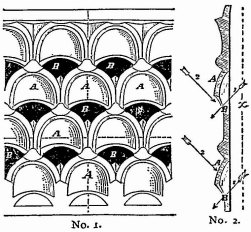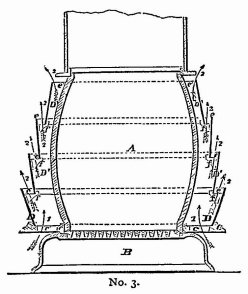
Case No. 13,556.
23FED.CAS.—18
STUART et al. v. SHANTZ et al.
[6 Fish. Pat. Cas. 35; 29 Leg. Int. 332; 2 O. G. 524; 9 Phila. 376; Merw. Pat. Inv. 125.]1
Circuit Court, E. D. Pennsylvania.
Oct. 14, 1872.
PATENTS—CONSTRUCTION UPON DIFFERENT THEORIES—LICENSE—PLEADING—EFFECT OF ADMISSIONS IN ANSWER.
1. Where the defendants do not in their answer deny that they have been engaged in the manufacture and sale of guard-plates, in every material particular of construction and effect like the one described in complainants' patent, but deny merely that their guard-plates produce the effect of directing the radiant heat downward toward the floor, which is claimed by complainants as a peculiar merit of their patented guard-plate, the complainants might fairly have regarded the answer as admitting the fact of infringement.
2. A license under a patent, other than the one sued upon, can have no independent efficacy in protecting the defendants. If such patent is for the same invention as the patent sued upon, and of earlier date, it renders the patent sued upon void. If not for the same invention as the patent sued upon, it can confer no right to appropriate that invention.
3. In the patent for an “improved guard-plate for stoves,” granted to Stuart & Wemys, May 18, 1868, the inventor proposed to permit the passage only of those rays of heat from a stove-cylinder, which have a downward direction, thereby causing them to impinge upon the floor, and upon objects somewhat above it, upon the hypothesis that their function in heating an apartment would thus be more effectually performed; and the construction and operation of his mechanical device was adapted to that end. In the patent issued to W. L. McDowell, April 28, 1863, the inventor proposed to prevent the horizontal radiation of heat from the fire-box of the stove, and thus avert the danger of burning combustible substances in its vicinity, and to allow the heated air to pass only outward and upward. His contrivance was adapted in its structure and operation to effectuate this purpose. Held, that the devices of the Stuart & Wemys patent and the McDowell patent are constructed upon different theories, and intended for the production of different primary results. They fall into different categories, and are distinguishable from each other in form, design, and mode of operation.
4. The utility of complainants' invention seems to be demonstrated by the fact that its manufacture in large numbers was justified by the public recognition of its merits.
In equity. Final hearing on pleadings and proofs. Suit brought upon letters patent [No. 80,235] for an “improved guard-plate for stoves,” granted to complainants [David Stuart and others], as assignees of David Stuart and Alexander Wemys, July 21, 1868. The defendants [Enos Shantz and others] set up in defense a license under a patent granted William L. McDowell, April 28, 1863. The case therefore turned mainly upon the question of substantial identity between the inventions shown in these two patents, as affecting the validity of the patent of complainants. The nature of the two inventions is set forth in the opinion.

The above engravings represent the complainants' device. B, B, are openings partially covered by the guard-plates A, A, by which the rays of heat are deflected downward in the direction of the arrows, 1, 1.
The following engraving represents the McDowell device, in which the heated currents pass upward through the openings e, e, as shown by the arrows 2, 2:

C. Howson and Furman Sheppard, for plaintiffs.
Frank Wolfe, for defendants.
MCKENNAN, Circuit Judge. The complainants are assignees of Stuart & Wemys, of letters patent for an “improved guard-plate for stoves,” dated July 21, 1868, with the infringement of which the defendants are charged. It is not denied in the answer that the defendants have been engaged in the manufacture and sale of guard-plates, in 273every material particular of construction and effect, like the one described in the patent; but they deny merely that their guard-plates produce the effect of directing the radial heat downward toward the floor, which is claimed by the complainants as a peculiar merit of their patented guard-plate. The complainants might, therefore, fairly have regarded the answer as admitting the fact of infringement. Not so treating it, they have produced ample proof, that the guard-plates made by the defendants are substantial imitations of their own; and so that their rights have been infringed.
In justification of this infringement the defendants set up a license from W. L. McDowell, to whom letters patent, dated April 28, 1863, were granted, and allege that, in the construction of their guard-plates, they have conformed to the method indicated in that patent. It is unnecessary, however, to consider this license, because it can have no independent efficacy in protecting the defendants. If Mr. McDowell's invention is not the same as that of Stuart & Wemys, he could confer no right upon any one to appropriate the invention of the latter. If both are identical in principle, construction, and operation, the patent of Stuart & Wemys is void, because it is subsequent to McDowell's, and the defense of respondents is complete, irrespective of the license. The only material inquiry then is, whether the patent of McDowell describes the same invention described and claimed in the patent of Stuart & Wemys.
Two objects are aimed at in the complainants' invention: (1) The concealment of the fire-pot of the stove; and (2) the direction of the radiant heat downward toward the floor. These objects are effectuated by the employment of a guard-plate consisting of a series of projections or deflecting shields, united by ornamental tracery, and so arranged as to leave open spaces, above and outward, from which the projections extend. The fire-pot is thus concealed from view, and the horizontal and upward radiation of heat is intercepted, only those rays which have a downward direction being allowed to pass freely through the chimneys. This is very concisely stated by Dr. Cresson, in his deposition, in which he says: “In the complainants' patent, I find the fire-pot surrounded by a shield with perforations. These perforations are shielded with a projecting cover or roof, which conceals the fire-pot from the eye, when looked at from a distance of several feet above the floor, and cuts off a majority of the rays of radiant heat, which would otherwise be given off in an upward direction or above a horizontal line; at the same time they permit the rays of radiant heat, that will pass through these openings, to impinge upon the floor and upon objects somewhat above it. The radiant rays that I refer to are those given out by the fire-pot itself. These covers to the openings act, at the same time, as reflectors of a portion of radial heat, giving it a downward direction.”
The object of the McDowell invention is avowedly different. In his specification, he says: “In nearly all the stoves in common use, especially those having cast-iron fireboxes or cylinders, the heat is permitted to radiate horizontally, and the said cylinders being generally kept red-hot, there is consequently danger of their charring or ‘setting fire’ to one's clothing, or any combustible substance in its vicinity. The stoves used in railroad cars, especially, are generally subject to this very objectionable feature. To obviate this objection in a perfect manner, and without preventing the required diffusion of the radiating heat through the air around the stove, is the object of my invention.”
This object is accomplished by “making the fender of a series of deflectors, consisting of short, hollow frustrums of cones, or other suitable forms of sheet metal, and arranging them around the outer side of the fire-cylinder or box, so as to be supported together upon the said perforated supplementary top plate of the base, leaving sufficient spaces between the said deflectors, and between the latter and the stove, for the hot air to pass obliquely outward and upward from the cylinder or fire-box, into the surrounding external air.”
These devices are distinguishable, therefore, not only in their form of construction, but also just as essentially in their intended mode of operation and the effects to be produced by them. In the one case the inventor proposed to permit the passage only of those rays of heat from a stove-cylinder which have a downward direction, thereby causing them to impinge upon the floor and upon objects somewhat above it, upon the hypothesis that their function in heating an apartment would thus be most usefully and effectually performed, and so he adapted the form, construction, and operation of his mechanical device to that end. On the other hand, it was proposed to prevent the horizontal radiation of heat from the fire-box of a stove, and thus avert the danger of burning combustible substances in its vicinity, and to allow the heated air around the stove to pass only obliquely outward and upward into the external atmosphere, and the inventor devised a mechanical contrivance peculiar in its structure and mode of operation to effect his purpose. Constructed, therefore, upon different theories, and intended for the production of different primary results, and with peculiar mechanical adaptations, the inventions in question fall into distinct categories, and so are distinguishable in form, design, and mode of operation from each other.
Of the efficiency of the complainants' invention, either in the light of its practical success, or of the conformity of its alleged mode of operation to the scientific laws 274which govern the radiation of heat, it is scarcely necessary to speak. Its utility seems to be demonstrated by the fact that its manufacture in large numbers, was fully justified by the public recognition of its merits and its preferential use, while but a very small number of the McDowell improvement has ever been made or sold. It may, therefore, be assumed that the effects claimed to be produced by it are produced to a useful and valuable extent. There may be scientific reasons for denying the positive agency of the shields in deflecting the radiant heat, which is projected against them toward the floor, but this is true only in a narrow sense and by a very literal interpretation of the patent. They certainly serve the inventor's purpose of intercepting upward and horizontal radiation, and permitting the escape only of those rays which have a downward tendency. Understood in the sense which the inventor's theory indicates, they exert at least a passive agency in directing the heat to the floor, where it is most available for proper dissemination through the apartment to be heated. A decree will therefore be entered for an injunction and an account.
STUART, The JOHN. See Case No. 7,427.
1 [Reported by Samuel S. Fisher, Esq., and here reprinted by permission. Merw. Pat. Inv. 125, contains only a partial report.]
This volume of American Law was transcribed for use on the Internet
through a contribution from Google. 